What is an Electronics Engineer Cover Letter
An electronics engineer cover letter is a crucial document that accompanies your resume when applying for electronics engineering positions. It serves as an introduction, a personal statement, and an opportunity to showcase your qualifications, skills, and enthusiasm for the role. Unlike a resume, which provides a factual overview of your experience, a cover letter allows you to tell a story, connect with the employer on a more personal level, and explain why you’re the perfect fit for the job. A well-crafted cover letter can significantly increase your chances of landing an interview.
Why You Need a Stellar Electronics Engineer Cover Letter
In the competitive field of electronics engineering, a strong cover letter is not just recommended; it’s essential. It’s your first impression, your chance to stand out from other applicants, and the primary way to convince a hiring manager that you’re worth their time. A stellar cover letter demonstrates your communication skills, attention to detail, and genuine interest in the specific company and role. It allows you to elaborate on your resume, providing context and depth to your achievements, skills, and projects. It also shows that you’ve taken the time to carefully consider the position and tailor your application accordingly. Without a well-written cover letter, your resume may be overlooked, and you could miss out on valuable opportunities.
Understanding the Purpose of a Cover Letter
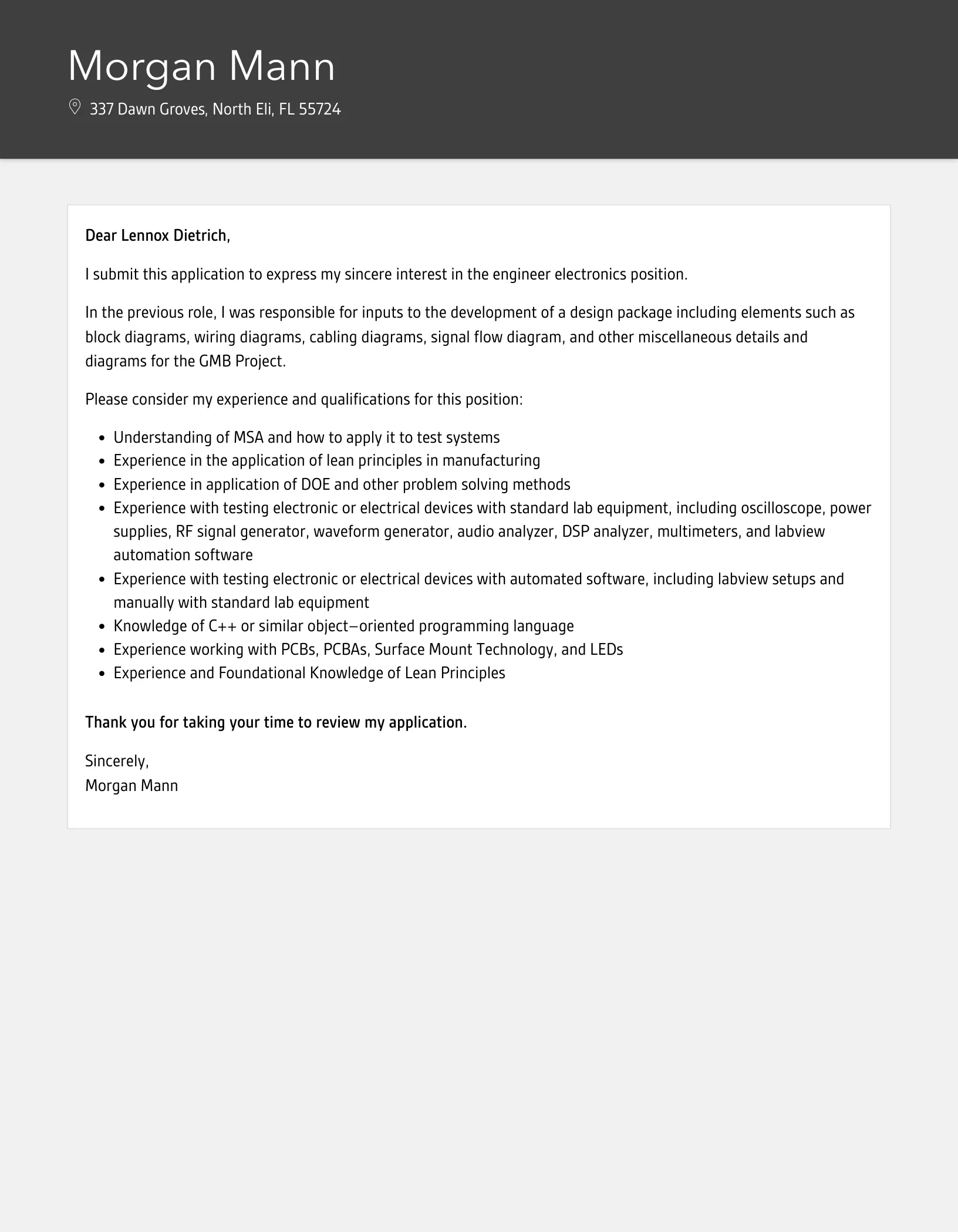
The primary purpose of an electronics engineer cover letter is to introduce yourself and express your interest in a specific job. It should highlight your key skills and experiences, explaining how they align with the job requirements and the company’s needs. A cover letter provides context for your resume, allowing you to elaborate on your accomplishments and demonstrate your passion for electronics engineering. It’s also an opportunity to show your personality and communication skills. In essence, it’s a marketing tool that showcases your value and persuades the employer to invite you for an interview. Always remember that the purpose is to get the interview.
Highlighting Your Skills and Experience
Your cover letter should prominently feature your relevant skills and experiences. Focus on the qualifications and expertise that are most relevant to the job description. Highlight your technical skills, such as proficiency in circuit design, PCB layout, programming languages (e.g., C++, Python), and simulation software (e.g., SPICE, Multisim). Provide concrete examples of how you’ve applied these skills to successfully complete projects. Quantify your accomplishments whenever possible, using metrics to demonstrate the impact of your work. For instance, instead of saying ‘Improved system performance,’ you could write ‘Improved system performance by 15% by optimizing the power supply design.’ Your cover letter is an opportunity to showcase your technical abilities, problem-solving skills, and hands-on experience to potential employers.
Essential Components of an Electronics Engineer Cover Letter
Your Contact Information
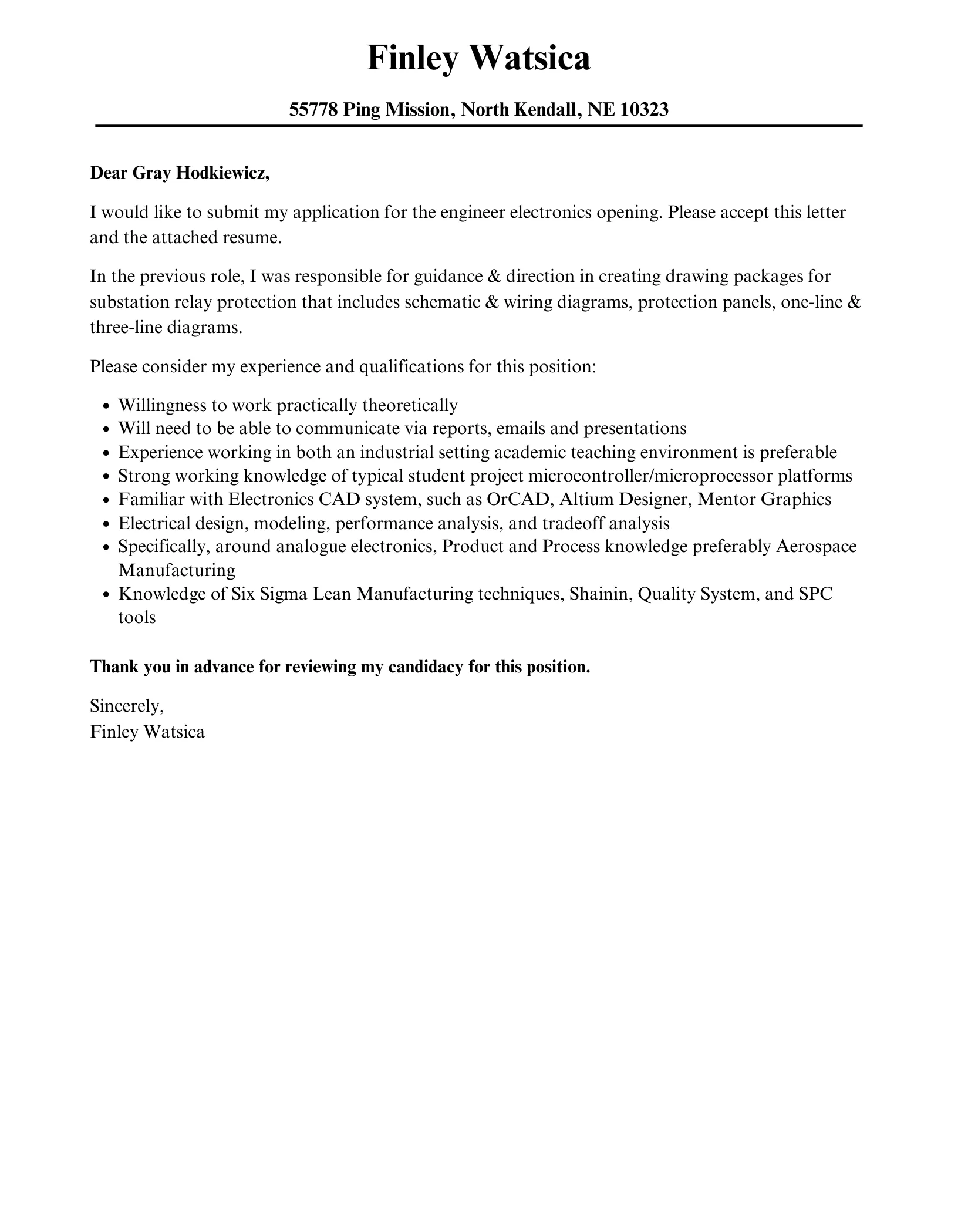
At the top of your cover letter, include your full name, address, phone number, and professional email address. Ensure your contact information is accurate and up-to-date. Use a professional-sounding email address (e.g., john.doe@email.com) rather than a casual or informal one. Make it easy for the hiring manager to contact you. The contact information should be easy to read and clearly presented, typically aligned to the left or right side of the page.
The Salutation
Address your cover letter to a specific person whenever possible. Research the hiring manager’s name on the company website or LinkedIn. Use a formal salutation such as ‘Dear Mr./Ms./Dr. [Last Name].’ If you can’t find a specific name, use a general greeting such as ‘Dear Hiring Manager’ or ‘Dear [Department Name] Team.’ Avoid generic greetings like ‘To Whom It May Concern,’ as they can make your letter seem impersonal. Always spell the name correctly, paying close attention to titles and any special characters.
Writing a Compelling Opening Paragraph
The opening paragraph is your chance to grab the reader’s attention. State the position you’re applying for and where you found the job posting. Briefly mention your most relevant qualifications and express your enthusiasm for the role and the company. Show the reader why you are a good fit. Consider including a strong sentence that highlights your key skill or accomplishment. The goal is to make the reader want to learn more. Avoid generic opening lines; instead, tailor your opening to the specific job and company, showing you’ve done your research. Make a positive statement about the company if possible.
Showcasing Your Technical Skills and Projects
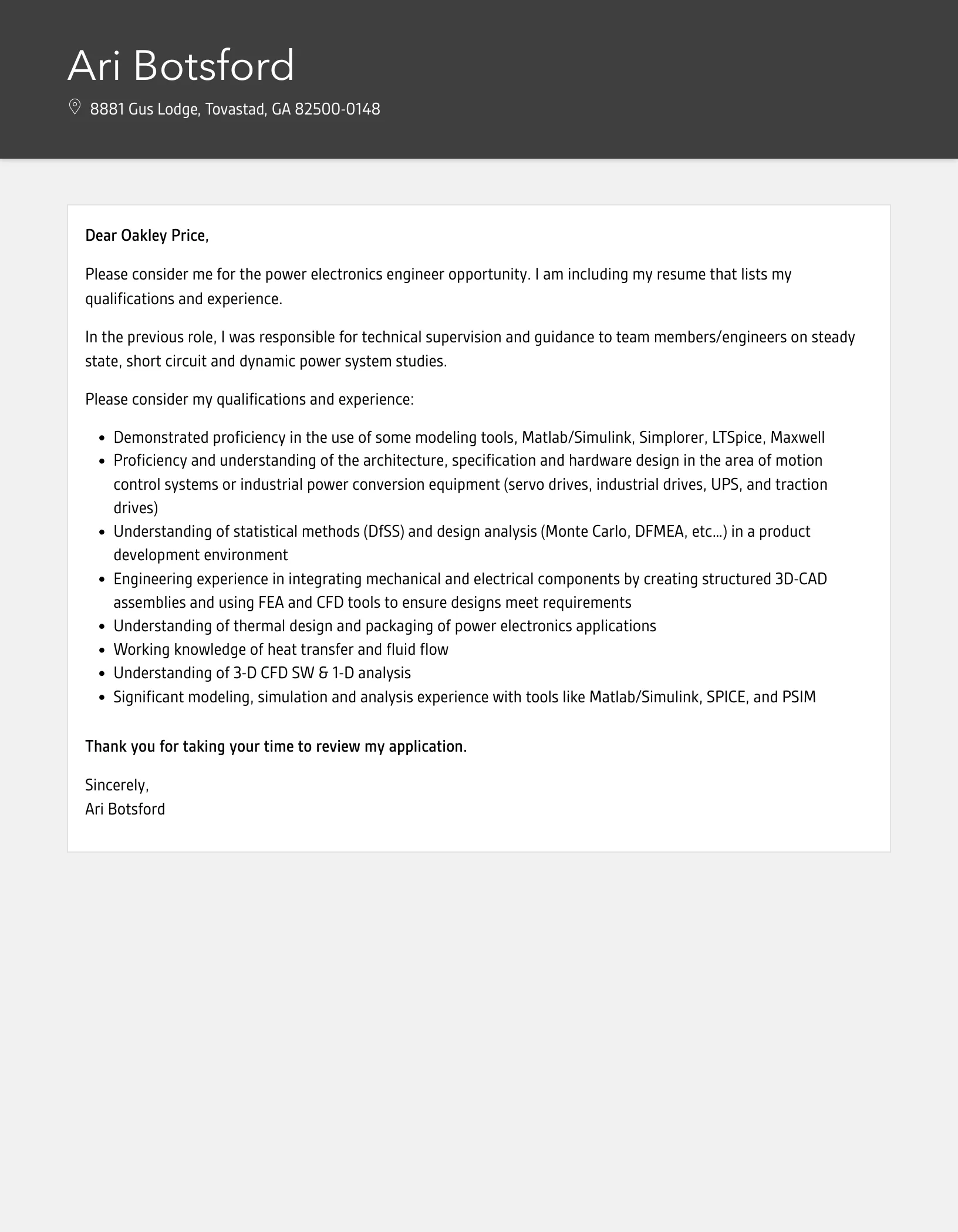
In the body of your cover letter, provide details about your technical skills and relevant projects. Describe your experience with specific technologies, tools, and methodologies. Give examples of projects where you successfully designed, implemented, or tested electronic circuits, systems, or components. Explain your role in each project, your responsibilities, and the results you achieved. If you have experience with specific software, hardware, or protocols, be sure to mention them. It is important to connect your experience to the job requirements, demonstrating how your skills and experience align with the company’s needs. Make sure to emphasize the positive outcomes or achievements that show your ability.
Quantifying Your Accomplishments
Whenever possible, quantify your accomplishments to demonstrate the impact of your work. Use numbers, percentages, and specific metrics to showcase your achievements. For example, instead of saying ‘Improved system efficiency,’ say ‘Improved system efficiency by 20% through the implementation of a new power management strategy.’ Quantifiable achievements provide concrete evidence of your skills and capabilities. Use data to support your claims, and make sure your accomplishments are relevant to the job requirements. Quantifying your results will make your cover letter much more compelling and impactful, proving your ability to produce results.
Addressing the Employer’s Needs
Tailor your cover letter to address the employer’s specific needs. Review the job description carefully and identify the key requirements, skills, and responsibilities. Highlight how your skills and experiences align with those needs. Explain how you can contribute to the company’s goals and objectives. Demonstrate your understanding of the company’s mission and values. Show that you have researched the company and are genuinely interested in the position. By directly addressing the employer’s needs, you demonstrate that you’re a proactive candidate who is focused on adding value.
Closing and Call to Action
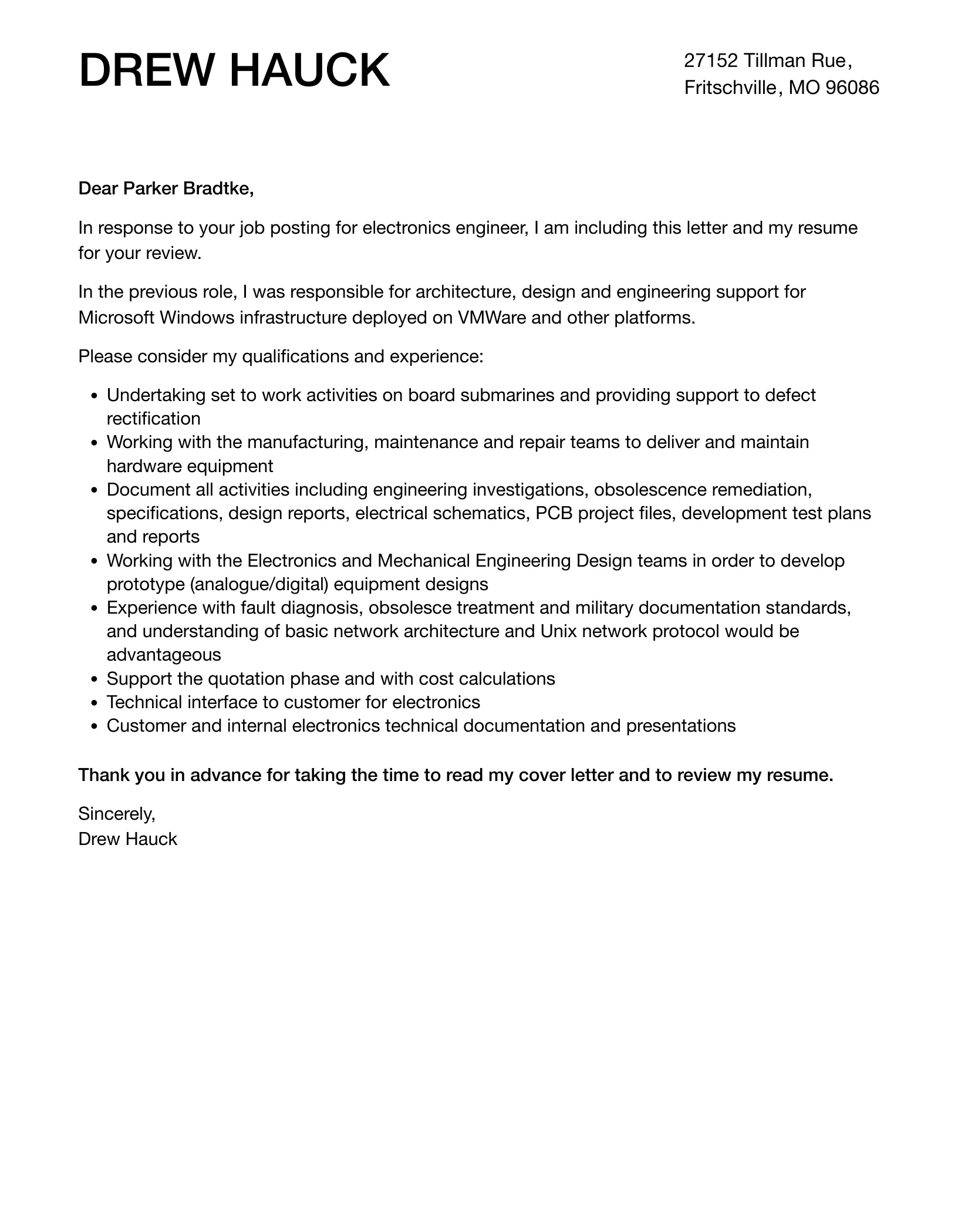
In your closing paragraph, reiterate your interest in the position and express your enthusiasm for the opportunity. Summarize your key qualifications and skills, emphasizing how you can contribute to the company. Include a call to action, such as ‘I am eager to discuss my qualifications further in an interview’ or ‘I look forward to hearing from you soon.’ Thank the reader for their time and consideration. End with a professional closing, such as ‘Sincerely’ or ‘Respectfully,’ followed by your name. This will complete your cover letter and demonstrate your professionalism.
Formatting Your Electronics Engineer Cover Letter
Choosing the Right Font and Size
Use a professional and easy-to-read font, such as Times New Roman, Arial, or Calibri. The font size should be between 10 and 12 points. Ensure the font size is consistent throughout the document. Avoid using overly decorative or unusual fonts that might distract the reader. Maintain a professional and clean appearance to ensure your cover letter is easy to read and visually appealing. Also, use a standard font for the entire cover letter.
Using Proper Grammar and Spelling
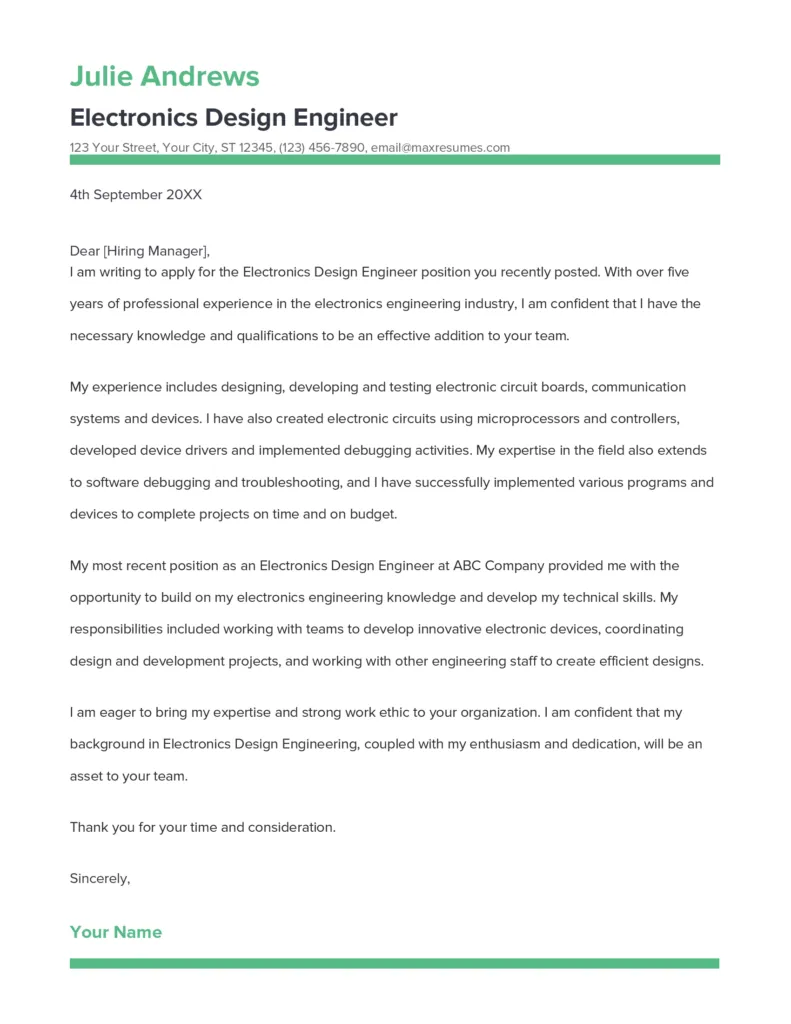
Proofread your cover letter carefully for any grammatical errors and spelling mistakes. Use a grammar checker and spell-check tool to identify any potential issues. Errors can make your cover letter look unprofessional and can damage your credibility. Take the time to review your cover letter thoroughly. If possible, ask a friend or family member to proofread it as a fresh pair of eyes may catch errors you missed. A polished and error-free cover letter shows your attention to detail and professionalism.
Keeping it Concise and Focused
Keep your cover letter concise and focused. Aim for one page, unless specifically instructed otherwise. Avoid unnecessary jargon, overly long sentences, and irrelevant information. Make every word count. Focus on the most important aspects of your qualifications and experience. Conciseness demonstrates respect for the reader’s time and allows you to effectively communicate your key messages. Be clear, precise, and to the point. Prioritize the information most relevant to the job requirements.
Tailoring Your Cover Letter
Researching the Company and Role
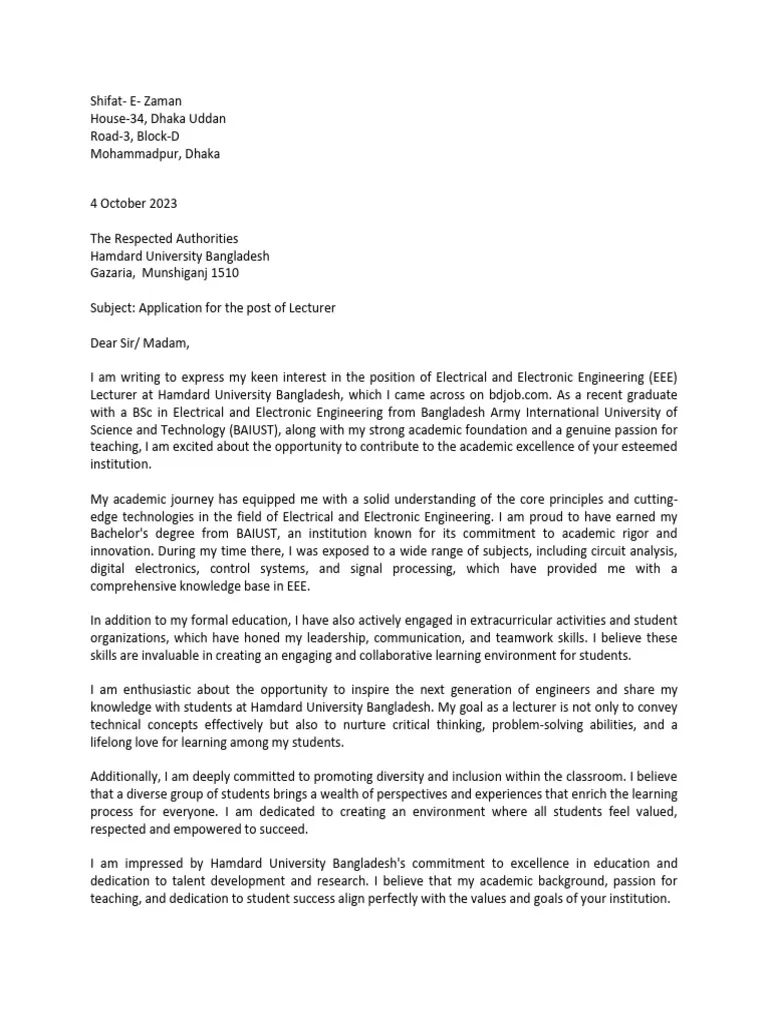
Before writing your cover letter, research the company and the specific role. Visit the company’s website, read industry news, and check their social media profiles. Understand the company’s mission, values, products, and services. Analyze the job description carefully to understand the required skills and responsibilities. Tailor your cover letter to demonstrate your knowledge of the company and your understanding of the role. This shows that you are genuinely interested in the opportunity and have taken the time to learn about the organization.
Customizing for Each Application
Never use a generic cover letter for multiple job applications. Customize each cover letter to match the specific requirements of the job and the company. Tailor your language, skills, and experiences to align with the job description. Highlight the aspects of your background that are most relevant to the role. Personalize your cover letter by mentioning the company’s specific projects, achievements, or values. By customizing your cover letter, you demonstrate that you’ve put in the extra effort and are genuinely interested in the position. This will significantly increase your chances of getting noticed by the hiring manager.
Reviewing and Editing Your Cover Letter
Proofreading for Errors
Proofread your cover letter multiple times for any errors in grammar, spelling, punctuation, and formatting. Errors can create a negative impression and undermine your credibility. Use a grammar checker, and a spell checker to help identify any issues. Read your cover letter aloud to catch any awkward phrasing or sentences that do not flow well. Pay close attention to details. Ensuring your cover letter is error-free demonstrates your attention to detail and professionalism. A well-proofread cover letter shows that you care about the quality of your application.
Seeking Feedback from Others
Ask a friend, family member, or career counselor to review your cover letter. A fresh pair of eyes can often catch errors or suggest improvements that you may have missed. Ask for feedback on the clarity, structure, and content of your cover letter. Get input on whether your cover letter effectively showcases your skills and experience. Consider their suggestions and make revisions as needed. Obtaining feedback from others can help you refine your cover letter and increase your chances of making a positive impression.
Example Electronics Engineer Cover Letter
Your Name Your Address Your Phone Number Your Email
[Date]
Hiring Manager Name (if known) Hiring Manager Title Company Name Company Address
Dear [Mr./Ms./Mx. Last Name],
I am writing to express my enthusiastic interest in the Electronics Engineer position at [Company Name], as advertised on [Platform]. With [Number] years of experience in designing and developing electronic systems, coupled with a strong foundation in circuit analysis and embedded systems, I am confident that my skills and experience align perfectly with your requirements. (electronics-engineer-example.webp)
In my previous role at [Previous Company], I was responsible for [briefly describe key responsibilities and accomplishments]. I have a proven track record of successfully designing and implementing [mention specific projects or technologies]. For example, I improved the efficiency of [system] by [percentage] through [specific action].
I am proficient in various programming languages, including [list languages], and experienced with software such as [list software]. I am also familiar with industry standards and regulations.
I am particularly drawn to [Company Name] because of [mention something specific about the company that interests you]. I am excited about the opportunity to contribute my skills and experience to your team.
Thank you for your time and consideration. I have attached my resume for your review and welcome the opportunity to discuss my qualifications further.
Sincerely, [Your Name]
Key Takeaways
Crafting an effective electronics engineer cover letter is crucial for making a positive impression and securing an interview. Always tailor your cover letter to each job application, highlighting the skills and experiences that are most relevant to the role. Quantify your accomplishments with numbers, percentages, and metrics to demonstrate the impact of your work. Proofread your cover letter carefully for any errors in grammar, spelling, and formatting. Seek feedback from others to refine your letter and improve its effectiveness. By following these guidelines, you can create a compelling cover letter that showcases your qualifications and increases your chances of landing your dream job. Use the tools available to check your content and proofread the finished product. Good luck with your job search! (electronics-engineer-success.webp)
